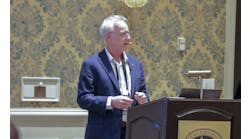Through the lens of history, it’s sometimes easy to identify moments in time that capsulize the key insights and decisions that made a business venture successful. For Barry Baker, vice president of Trihedral, a Delta Group Company, one of those crystalline moments occurred 20 years ago in a Tampa, Fla., conference room.
He and his Trihedral colleagues were pitching the company’s relatively new VTScada software—an all-in-one platform for human-machine interface (HMI) and supervisory control and data acquisition (SCADA) applications—to local water treatment authorities. Sure, they went through all the features and technical specs of the product, but what sticks in Baker’s mind was relating his company’s guiding business tenets to the client, which he now realizes have remained fundamentally unchanged since the company’s founding: commitment, ongoing support, partnership and professional excellence.
“Commitment means we can sleep at night because we know our system is safe and reliable,” Baker said during his keynote session presentation at VTScadaFest 2023, the training, education and networking event for users of the company’s software. New features are important of course, but safety and reliability are key, Baker said. “The number of cup holders is not.” Fast forward 20 years, and “we’re about to do an air traffic control SCADA system for an entire continent,” he added.
A second business tenet from 20 years ago was to be a source of consistent, long-term support to their customers. And although it seems unlikely that even Baker would have predicted it then, the applications developed for those earliest VTScada releases will run unmodified on today’s latest version. Further, optional system support and upgrades continue to be available for an annual fee. That price remains frozen for perpetuity while support stays current.
The third tenet, partnership, is evident in the company’s relationships with hundreds of integrators and thousands of unique customers in over 100 countries around the world. Plus, parent company Delta’s robust partnerships and commitment to sustainability fit well with VTScada’s culture.
Professional excellence is the fourth and final aspect of a business philosophy that continues to pay dividends, Baker said, even as the team eyes another 20 years of commitment, support and partnership. “And this event is the centerpiece of professional development,” he added, referring to VTScadaFest’s extensive training sessions, educational program and Developers’ Den where the company’s subject matter experts continue to solve problems and advance the competencies of industrial practitioners from around the world.
Oh, and what ever became of those prospective VTScada users in that Tampa conference room 20 years ago? They bought in, and their systems are still up and running two decades on.
State logic pioneer
If steadfast commitment to the business principles that Baker described constituted half the reason for VTScada’s success, then a series of innovative early decisions on product development set the foundation for the other half.
For that part of the story, we turn to President Glenn Wadden’s VTScadaFest presentation on the “crucial underpinnings” of VTScada. “The key ideas and pieces of VTScada that make it what it is today,” Wadden said.
In the mid-80s, Wadden was developing HMIs and programming PLCs for hire, but found that every system was different, and he had to start each project from square one. “Something more flexible was needed,” Wadden said, and that realization ultimately led him to develop the event-driven, state-logic-based coding language that became VTScadaScript.
“VTScada is, at its core, a programming language, a visual tag system (or VTS) that generates code in the background based on what you see on the screen,” Wadden began. That visual programming language has since been web-enabled, and had scripting and other functionalities added to it, but its core has otherwise remained the same, he explained. “That’s why we have that backward compatibility—we’re always adding to it but never taking away.”
Further, the language itself is based on state logic, which at the time Wadden developed the first VTS (later to become VTScada), had not yet been applied to a software language. “State logic itself dates to the 1940s, to digital electronic circuits,” he explained. Having learned about state logic at university, he thought it made sense to implement it in software—and first did so in 1986, the year before the first paper on state logic applied to a software language emerged in 1987. “VTScada is still the only programming language based on state logic,” Wadden said.
And what is it that makes state logic special? First, it’s important to understand that software performance is inherently dependent on the number of variables interacting. Classical software programming is based on input-process-output, but data is changing, time is passing, and the more variables interact, the more things can go wrong. In fact, the number of interactions rises with the square of the number of variables, so complexity can quickly escalate.
State logic, on the other hand, “restricts the view to the things that matter, looking only at what effects a change propagates,” Wadden said. Similar to reporting by exception, this event-driven approach means the program needs to deal with fewer variables within an organized hierarchy. In the end, this translates to simplified code, with fewer bugs, that executes faster. “Performance is no longer dependent on scale,” Wadden added, “but rather how many things change.”
VTScada also gains performance from its object-orientation, Wadden said. “In VTScada, every tag is an object, as is every report, every form,” he said. “It was created this way because at the time there was nothing else capable of doing the job.”
Other ways that VTScada benefits from object-oriented princip6els include late binding and layering. “Late binding means you can change what happens on the fly, overriding the previous configuration without the need to recompile,” Wadden explained. “It’s especially liberating for running systems—you don’t need to shut down to make a change.” Similarly, layering refers to how applications run on top of the core and inherit the qualities of core; and the same for user code on top of that. Updates to upper layers don’t affect those below.
One final differentiating feature of VTScada is inherent version control. This means the application software itself carries within it a record of every change that's ever been made. Each programming change is an internally logged event; the application software captures the nature of the change, when it was made, and who made it. Each of these events can be examined independently and reversed or corrected as necessary. And that reversal or correction becomes yet another event that's captured by the system, so it too can be changed. It's no wonder some development teams have called this feature their guardian angel.
Try VTScada for yourself with a free version of their award-winning SCADA software, perfect for small industrial and personal applications with up to 50 I/O: VTScadaLIGHT.




